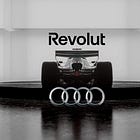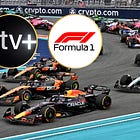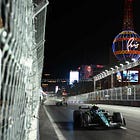Cadillac Bets Big on Bottas and Perez
Cadillac F1 Team signs Valtteri Bottas and Sergio Perez
You are receiving this email because you subscribed to Business of Speed, the newsletter for those wanting to stay ahead on what’s happening behind the scenes. I’m Vincenzo Landino, a business, tech, and F1 commentator. I’ve spent the last ten years at the intersection of content, partnerships, and the business of motorsport. This newsletter is where I break down what’s working, what’s shifting, and what’s next without the PR gloss. Thank you for being here.
On Tuesday, the incoming Cadillac F1 team announced Sergio "Checo" Pérez and Valtteri Bottas as their driver lineup for 2026. This move screams ambition while quietly revealing the harsh realities of breaking into Formula 1's elite circle.
One must understand that Formula 1 is a $ 3 billion+ global sponsorship machine.
The Mexican market expansion is worth hundreds of millions, and American corporate brands may finally get their F1 breakthrough.
The Mexican Marketing Machine
Let's start with the obvious win.
Pérez brings Carlos Slim. The billionaire’s Telmex empire has backed the Mexican driver throughout his career. While exact figures remain confidential, industry insiders suggest this partnership could deliver $15-40 million annually in sponsorship value to Cadillac.
But there’s a big bonus by signing Checo: Mexico's F1 fanbase explosion. Since Pérez joined Red Bull, his popularity has "skyrocketed" from respected athlete to legitimate celebrity status. The Mexico City Grand Prix now sells over 400,000 tickets annually, making it the third-largest Formula 1 event globally. Fox Sports Mexico's Diego Meija put it perfectly: "Boom, Checo's popularity was suddenly mega".
For Cadillac, this means instant access to a market where F1 viewership has grown in tandem with Pérez's. The biggest Mexican brands actively seek partnerships with him, viewing Pérez as the "perfect ambassador for Mexico". That becomes a direct pipeline to corporate sponsorship dollars that could dwarf what most F1 teams secure from secondary markets.
Bottas Blueprint
While Pérez brings the money and marketing, Bottas brings the blueprint. This matters more than people realize.
Bottas spent five years inside Mercedes during their championship dominance (2017-2021), accumulating 10 wins and 58 podiums while helping secure five constructors' championships. That's not just racing experience — that's institutional knowledge of what championship-level operations actually look like.
Team CEO Dan Towriss was explicit about this: "Their technical acumen are really what we need. It's the right combination, the right drivers at the right time". Translation: Cadillac isn't paying for wins in 2026. They're paying for operational intelligence that could accelerate their development by years.
Cadillac is building everything from scratch across facilities in Silverstone, Indianapolis, and Charlotte. Having a driver who understands Mercedes-level car development, technical feedback loops, and championship team dynamics is worth millions in avoided mistakes alone.
American Sponsorship
F1's American sponsorship boom has reached unprecedented levels, with 34% of new deals coming from U.S. companies. That’s the highest of any nation.
Cadillac enters this market as a true American-branded team (sorry, Gene), giving it exclusive access to corporate sponsors who've been priced out elsewhere. Remember, the average F1 sponsorship deal now costs $6.01 million, compared to $745,000 in the NFL. Most American brands can't afford McLaren or Mercedes rates.
And Cadillac offers something unique: authentic American motorsport heritage combined with F1's global platform. Companies like MoneyGram (paying over $ 40 million to sponsor Haas), American Express, and Visa have already demonstrated a significant appetite for F1 partnerships.
The Pérez-Bottas signing signals to these brands that Cadillac is serious about competitive performance and marketing visibility. That credibility gap between the startup team and a legitimate F1 operation is worth tens of millions in sponsor confidence.
Reality Check
Let’s get this out of the way. Cadillac will start at the back of the grid, and both drivers are aware of that.
Team principal Graeme Lowdon has "played down expectations," and Pérez acknowledged he's "under no illusions about Cadillac's potential in its first season". Industry experts suggest that if Cadillac can "outqualify people with any regularity on merits, that would have been a sensational achievement".
But here's why the Pérez-Bottas pairing makes sense: 527 combined race starts and 16 wins between them mean this team shouldn’t make rookie mistakes. They'll maximize whatever performance the car delivers while providing crucial development direction for future seasons.
More importantly, both drivers have experience with championship-level pressure. Pérez finished runner-up in 2023, while Bottas was runner-up twice (2019, 2020). They understand what it takes to compete at F1's highest level, which will be invaluable when Cadillac's car eventually becomes competitive.
The Long Game
This signing reveals Cadillac's true timeline. They're building toward 2029-2030 when their own engines come online and the team matures operationally.
Pérez and Bottas provide immediate credibility while Cadillac develops infrastructure. By the time these drivers move on, the American team should have established technical partnerships, proven operational competence, and secured long-term American corporate sponsors who see F1 as essential to their global marketing strategies.
The $450 million anti-dilution fee that Cadillac has already paid to existing teams demonstrates its commitment to this long-term investment. Hiring proven drivers is about protecting that investment with experienced professionals who won't accidentally damage the brand during its vulnerable startup phase.
If you know someone who has been watching F1's American expansion or wondering how traditional automakers plan to compete with tech companies in motorsport, send them this breakdown. The business model here extends far beyond racing, and frankly, every sports marketing exec should be paying attention.
You are receiving this email because you subscribed to Business of Speed, the newsletter for those wanting to stay ahead on what’s happening behind the scenes. I’m Vincenzo Landino, a business, tech, and F1 commentator. I’ve spent the last ten years at the intersection of content, partnerships, and the business of motorsport. This newsletter is where I break down what’s working, what’s shifting, and what’s next without the PR gloss. Thank you for being here.








